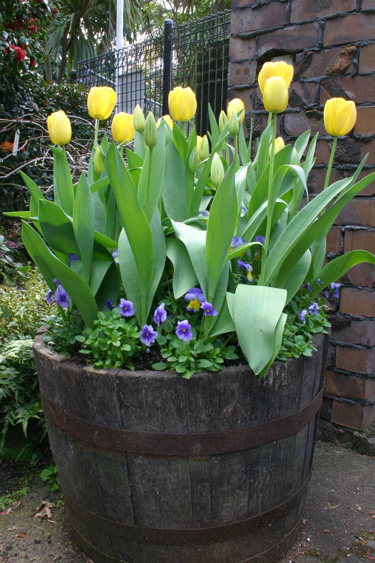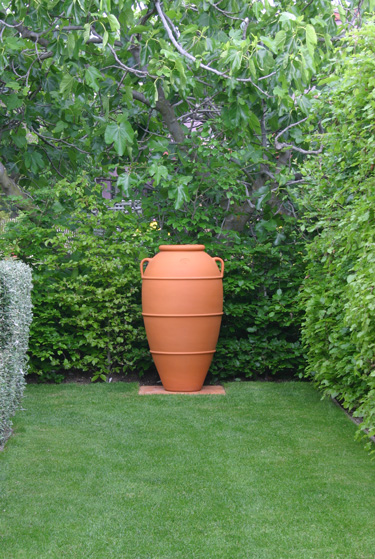Top tasks for autumn
Autumn is planting time – for almost everything you could want to plant, but it is the very best time to sow new lawns and to plant trees, and the only time to plant spring flowering bulbs.
Plant trees and shrubs
A garden without trees or shrubs can feel pretty desolate when winter comes around. But if you plant for a great looking garden in winter, spring will pretty much take care of itself. It’s trees and shrubs that give a garden its structure, a background setting for the flowers that only show up in their season. Of course some of the most spectacular seasonal displays come, year after year, from permanent plantings of trees and shrubs.
Planted as hedges or clipped as topiary, trees and shrubs provide accent and order, whether you use them to create privacy or tidy garden borders. To provide a strong foundation for your garden, a half to two thirds of your planting should be trees and shrubs.
A well placed tree is an asset, visually anchoring a house into its setting and enhancing street appeal while framing the outward views. There is no nicer shade than the dappled shade of a tree, and no nicer place for a hammock or swing.
Deciduous trees let the sun through in winter and create a haven for shade loving ‘woodland’ plants to grow beneath them. Evergreens offer year-round privacy and shelter.
PLANTING TIPS
- Water thoroughly to saturate the roots before planting.
- Dig a hole at least twice as wide and one and a half times deeper than the roots.
- Mix compost and controlled-release fertiliser into planting hole.
- Position stakes while you can still see the roots. Staking is important for most young trees to anchor the plant against wind while the roots get established. The best way is to have two stakes, one each side of the tree. Tie firmly with flexible ties.
- Water well after planting. Add a layer of mulch to retain moisture and block weeds.
- A tree is a long-term investment, so go for the best quality, best shaped tree you can buy.
- Don’t skimp on fertiliser or stakes and other protective measures (such as windbreak cloth or animal barriers) that will support a strong healthy start.
Plant bulbs for spring
March, April and May are our main bulb planting months. The more bulbs we plant, the greater the rewards during winter and early spring.
Be an early bird
Even if you plan to plant towards the end of the season, keep an eye out for bulb stocks arriving in garden centres (from March onwards) so you can procure your favourite varieties from the best of the new season’s stock. Tulip bulbs flower beautifully if they are kept in the fridge for eight weeks prior to planting.
Plant for impact
Even if you have only a few bulbs, they will make more of a statement if you plant in close groupings rather than scattering them about.
Fill pots with bulbs
Spring bulbs make excellent container plants. Their drainage needs can be accommodated very easily in pots, and once foliage begins to die down they can be moved from view. For best results plant in bulb planting mix. This ensures the right balance of drainage, water holding ability and controlled release fertiliser. Terracotta pots are ideal because they’re porous which helps to keep bulb roots cool. Generally bulbs are grown for just one season in a pot, so they can be planted so they are almost touching.
Plant under deciduous trees
Beautiful woodland bulbs include snowdrops, snowflakes, bluebells, and many daffodils. When planting bulbs under trees, compensate for soil- robbing tree roots by enriching the soil with moisture retentive compost and bulb fertiliser. Many bulbs, especially daffodils and bluebells can be left in the ground to flower year after year. Resist the temptation to cut down the foliage until at least six weeks after flowering if you want flowers the following year. If flowering seems in decline after a few years, overcrowding is the likely cause and it’s time to lift and divide.
COOL COMPANIONS
Cool season annuals; pansies, violas, primulas and forget-me-nots
are among the best flowers to plant with bulbs. Spring and summer flowering perennials such as catmint, Echinacea, Aquilegia (grannies bonnet) Penstemon, Achillea (yarrow), Salvia, Alchemilla (lady’s mantle), heucheras and cranesbill geraniums all make great bulb companions, remaining colourful after the bulb season has passed.
Sow a new lawn
Lawn seed that’s sown in autumn will quickly germinate and burst into lush green growth. This is the best time of year for new lawns because the soil is still warm but the air is cool and moist. Weeds are not quite as rife as they are in spring.
The flatter, sunnier and better drained your surface, the better your lawn will be. Allow a good couple of weeks to get the ground ready for sowing, by which time the weather will ideally have turned perfect with frequent spells of soft autumn rain, so you will barely need to water.
Once you have removed all weeds and thoroughly prepared your soil bed (more about this on www.gogardening.co.nz), you are ready to sow. But which seed is best for you?
Most lawn seed brands contain a mix of grass types, blended for each specific use.
For small feature lawns
If your lawn is mainly for looking at, with only light foot traffic, consider a superfine luxury lawn seed. These lawns require a little extra pampering in the way of watering, weeding and feeding, so are best suited to smaller areas.
For play areas
Lawns used for cricket and football, or as an occasional parking space, need hardwearing grasses. The best of today’s seed blends combine toughness with a lush green appearance.
For hot dry climates
Grasses with deep roots are the most tolerant of dry conditions. Look for mixtures containing fescues, Kentucky bluegrass and rye, or consider Kikuyu for frost-free gardens.
For seaside gardens
At the seaside a low rainfall often combines with sandy soil calling for the most drought tolerant grasses. Though considered a weed in many situations, tough and springy Kikuyu makes an ideal lawn at the bach and is tough enough to cope as a part time parking area.
For shady areas
Shade is not ideal for any lawn. Too much of it leads to thin weed-prone turf or excessive moss growth. However, some grasses, such as creeping red fescue and chewing fescue are more shade tolerant than others. Major lawn seed brands offer specific blends for shade.
Other attributes to look for in a lawn seed are speedy germination and fast establishment followed by slower growth, which means less mowing. Treatments that protect the seed from pests and diseases are also useful. Wear gloves when handling seed and wash your hands after use.
Keeping on top of weeds
The best defense against weeds is a thick healthy turf. Weeds love poorly drained, dry or under-fed lawns. Water during dry spells and apply lawn fertiliser in spring and autumn. Spraying with a selective herbicide in early spring will help prevent weeds (and prickles) taking hold of new lawn before it has fully matured. But wait until at least two months after germination before spraying.
SOWING TIP
For even seed distribution, take the recommended amount of lawn seed for your area and divide it into two. Scatter half in a north-south direction and the other half at right angles, in an east-west direction.
DESIGN TIP
Simple lawn shapes with crisp clean edges are both easy on the eye and easy to maintain. The more complicated and curvy your garden beds, the more edging you will have to maintain.
26-Mar-2015

Loropetalum 'Fire Dance'

Tulips and pansies in a barrel

A good lawn enhances a feature pot

